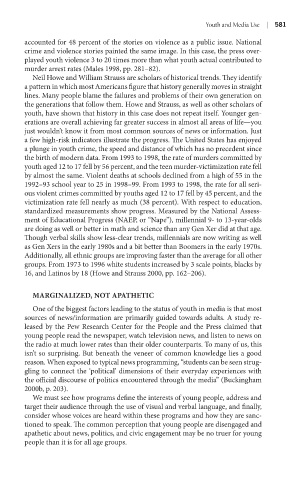Page 602 - Battleground The Media Volume 1 and 2
P. 602
Youth and Med a Use | 1
accounted for 48 percent of the stories on violence as a public issue. National
crime and violence stories painted the same image. In this case, the press over-
played youth violence 3 to 20 times more than what youth actual contributed to
murder arrest rates (Males 1998, pp. 281–82).
Neil Howe and William Strauss are scholars of historical trends. They identify
a pattern in which most Americans figure that history generally moves in straight
lines. Many people blame the failures and problems of their own generation on
the generations that follow them. Howe and Strauss, as well as other scholars of
youth, have shown that history in this case does not repeat itself. Younger gen-
erations are overall achieving far greater success in almost all areas of life—you
just wouldn’t know it from most common sources of news or information. Just
a few high-risk indicators illustrate the progress. The United States has enjoyed
a plunge in youth crime, the speed and distance of which has no precedent since
the birth of modern data. From 1993 to 1998, the rate of murders committed by
youth aged 12 to 17 fell by 56 percent, and the teen murder-victimization rate fell
by almost the same. Violent deaths at schools declined from a high of 55 in the
1992–93 school year to 25 in 1998–99. From 1993 to 1998, the rate for all seri-
ous violent crimes committed by youths aged 12 to 17 fell by 45 percent, and the
victimization rate fell nearly as much (38 percent). With respect to education,
standardized measurements show progress. Measured by the National Assess-
ment of Educational Progress (NAEP, or “Nape”), millennial 9- to 13-year-olds
are doing as well or better in math and science than any Gen Xer did at that age.
Though verbal skills show less-clear trends, millennials are now writing as well
as Gen Xers in the early 1980s and a bit better than Boomers in the early 1970s.
Additionally, all ethnic groups are improving faster than the average for all other
groups. From 1973 to 1996 white students increased by 3 scale points, blacks by
16, and Latinos by 18 (Howe and Strauss 2000, pp. 162–206).
marginaLizED, noT aPaThETiC
One of the biggest factors leading to the status of youth in media is that most
sources of news/information are primarily guided towards adults. A study re-
leased by the Pew Research Center for the People and the Press claimed that
young people read the newspaper, watch television news, and listen to news on
the radio at much lower rates than their older counterparts. To many of us, this
isn’t so surprising. But beneath the veneer of common knowledge lies a good
reason. When exposed to typical news programming, “students can be seen strug-
gling to connect the ‘political’ dimensions of their everyday experiences with
the official discourse of politics encountered through the media” (Buckingham
2000b, p. 203).
We must see how programs define the interests of young people, address and
target their audience through the use of visual and verbal language, and finally,
consider whose voices are heard within these programs and how they are sanc-
tioned to speak. The common perception that young people are disengaged and
apathetic about news, politics, and civic engagement may be no truer for young
people than it is for all age groups.

